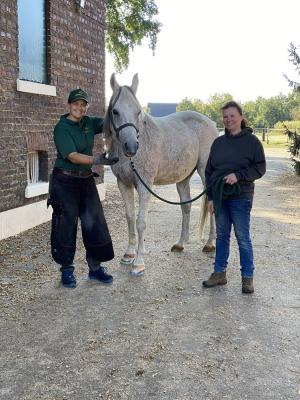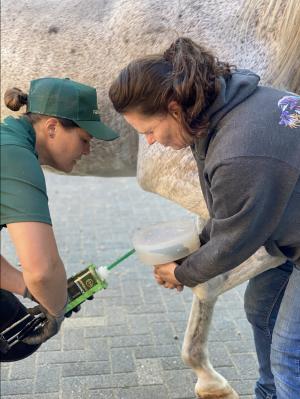[Sponsored Content]
Sponsored Content by FormaHoof – The Only Horseshoeing Method That Can Replicate The Natural Biomechanics Of The Perfect Barefoot Hoof
No hoof, no horse is a fact of life. And a good relationship with your farrier is the key to keeping your horse’s hooves as healthy as possible.
1. Make sure your horse is ready when your farrier arrives
There is nothing worse for a farrier than a horse with wet, mucky feet! Make sure your horse’s feet are clean, dry and picked out for when your farrier appointment is scheduled. Do not put any hoof oil or balm on the hooves on the day of your farrier visit.
2. Respect the schedule
A farrier’s life is a busy life, with many doing up to 15 horses a day, so you can only imagine how much chaos last minute calls and cancellations can cause! Make sure you stick to a regular schedule and call early if you need to make any changes. If your horse has a problem between scheduled visits, such as lost shoe or an injury, call your farrier right away to arrange whatever is needed.
3. Control the environment
For many horses, a farrier visit is routine, but for some it is stressful, particularly for youngsters that don’t yet have much experience with the farrier. A busy yard will only add to the stress, so make sure you find a quiet spot where you can control the environment while your horse is being trimmed or shod. Do not groom, pull manes, or do anything that could irritate your horse while your farrier is working.
4. Keep calm
Some horses may need a little help to stay calm and keep everyone safe during the farrier visit. If your horse gets extremely stressed and you feel may cause harm to you or your farrier, talk to your vet about a calmer or sedation. You can train your horse between cycles and prepare for the next visit by holding up legs for longer, moving in similar way to your farrier around the hooves, and stretching legs.
5. Ask questions and take advice
Go with the flow. Most farriers are up for a good chat, so if you feel that is the case take it and chat away. If you feel he is stressed and busy, keep conversation down to the necessities. If you have questions for your farrier – ASK.
If you would like to discuss a new equine podiatry solution such as FormaHoof, speak openly about it. Do your research before bringing it up, however, and be prepared with the information your farrier may need. Keeping an open line of communication will help your owner-farrier relationship.
6. Do your homework – Maintain good Hoof Care between visits
Maintaining good hoof care practices between farrier visits is key, including daily hoof picking and additional care to help prevent or aid recovery from hoof damage, disease, or injuries. If you neglect your horse’s feet between visits, there is only so much your farrier can do. It is the responsibility of every horse owner to maintain the feet in the best possible way between farrier visits.
7. Connect the dots - look out for changes in your horse’s feet
Inspect your horse’s feet daily, checking for damage and abnormalities. If you notice a minor change, keep an eye on it until the next scheduled visit and discuss it with your farrier. If you notice major changes, injuries, cracks, or lameness, connect the dots and speak to your farrier or vet (depending on your findings).
8. Be loyal - Build up a relationship and stay with your farrier
Loyalty is key to a trusting relationship with your farrier. Think about yourself, do you change your dentist, doctor, or even your hairdresser with every appointment? Probably not. Instead, you build a relationship based on trust in their work and qualifications. The same applies to a good owner – farrier relationship and changing your farrier frequently will not help your horse’s hoof development.
9. Pay your farrier promptly
Always try to pay your farrier on the day work is carried out. Most farriers are self-employed and rely on their clients’ payments to pay their own bills. In some yards, you may find farrier post boxes where you can deposit payment if you’re not around, or you can arrange to leave the payment in a secure location, or with the stable hand that attends the farrier visit for you. Just make sure your farrier is paid in a timely manner for the work done.
10. Be polite, friendly and be a good host
Be friendly with your farrier (and everyone else) and clean up any droppings as soon as they happen. If you are around, be a good host by asking your farrier if they want a coffee, tea, or water. You would be surprised how much of a difference it can make.
Sponsored Content by FormaHoof – The Only Horseshoeing Method That Can Replicate The Natural Biomechanics Of The Perfect Barefoot Hoof
No hoof, no horse is a fact of life. And a good relationship with your farrier is the key to keeping your horse’s hooves as healthy as possible.
1. Make sure your horse is ready when your farrier arrives
There is nothing worse for a farrier than a horse with wet, mucky feet! Make sure your horse’s feet are clean, dry and picked out for when your farrier appointment is scheduled. Do not put any hoof oil or balm on the hooves on the day of your farrier visit.
2. Respect the schedule
A farrier’s life is a busy life, with many doing up to 15 horses a day, so you can only imagine how much chaos last minute calls and cancellations can cause! Make sure you stick to a regular schedule and call early if you need to make any changes. If your horse has a problem between scheduled visits, such as lost shoe or an injury, call your farrier right away to arrange whatever is needed.
3. Control the environment
For many horses, a farrier visit is routine, but for some it is stressful, particularly for youngsters that don’t yet have much experience with the farrier. A busy yard will only add to the stress, so make sure you find a quiet spot where you can control the environment while your horse is being trimmed or shod. Do not groom, pull manes, or do anything that could irritate your horse while your farrier is working.
4. Keep calm
Some horses may need a little help to stay calm and keep everyone safe during the farrier visit. If your horse gets extremely stressed and you feel may cause harm to you or your farrier, talk to your vet about a calmer or sedation. You can train your horse between cycles and prepare for the next visit by holding up legs for longer, moving in similar way to your farrier around the hooves, and stretching legs.
5. Ask questions and take advice
Go with the flow. Most farriers are up for a good chat, so if you feel that is the case take it and chat away. If you feel he is stressed and busy, keep conversation down to the necessities. If you have questions for your farrier – ASK.
If you would like to discuss a new equine podiatry solution such as FormaHoof, speak openly about it. Do your research before bringing it up, however, and be prepared with the information your farrier may need. Keeping an open line of communication will help your owner-farrier relationship.
6. Do your homework – Maintain good Hoof Care between visits
Maintaining good hoof care practices between farrier visits is key, including daily hoof picking and additional care to help prevent or aid recovery from hoof damage, disease, or injuries. If you neglect your horse’s feet between visits, there is only so much your farrier can do. It is the responsibility of every horse owner to maintain the feet in the best possible way between farrier visits.
7. Connect the dots - look out for changes in your horse’s feet
Inspect your horse’s feet daily, checking for damage and abnormalities. If you notice a minor change, keep an eye on it until the next scheduled visit and discuss it with your farrier. If you notice major changes, injuries, cracks, or lameness, connect the dots and speak to your farrier or vet (depending on your findings).
8. Be loyal - Build up a relationship and stay with your farrier
Loyalty is key to a trusting relationship with your farrier. Think about yourself, do you change your dentist, doctor, or even your hairdresser with every appointment? Probably not. Instead, you build a relationship based on trust in their work and qualifications. The same applies to a good owner – farrier relationship and changing your farrier frequently will not help your horse’s hoof development.
9. Pay your farrier promptly
Always try to pay your farrier on the day work is carried out. Most farriers are self-employed and rely on their clients’ payments to pay their own bills. In some yards, you may find farrier post boxes where you can deposit payment if you’re not around, or you can arrange to leave the payment in a secure location, or with the stable hand that attends the farrier visit for you. Just make sure your farrier is paid in a timely manner for the work done.
10. Be polite, friendly and be a good host
Be friendly with your farrier (and everyone else) and clean up any droppings as soon as they happen. If you are around, be a good host by asking your farrier if they want a coffee, tea, or water. You would be surprised how much of a difference it can make.











